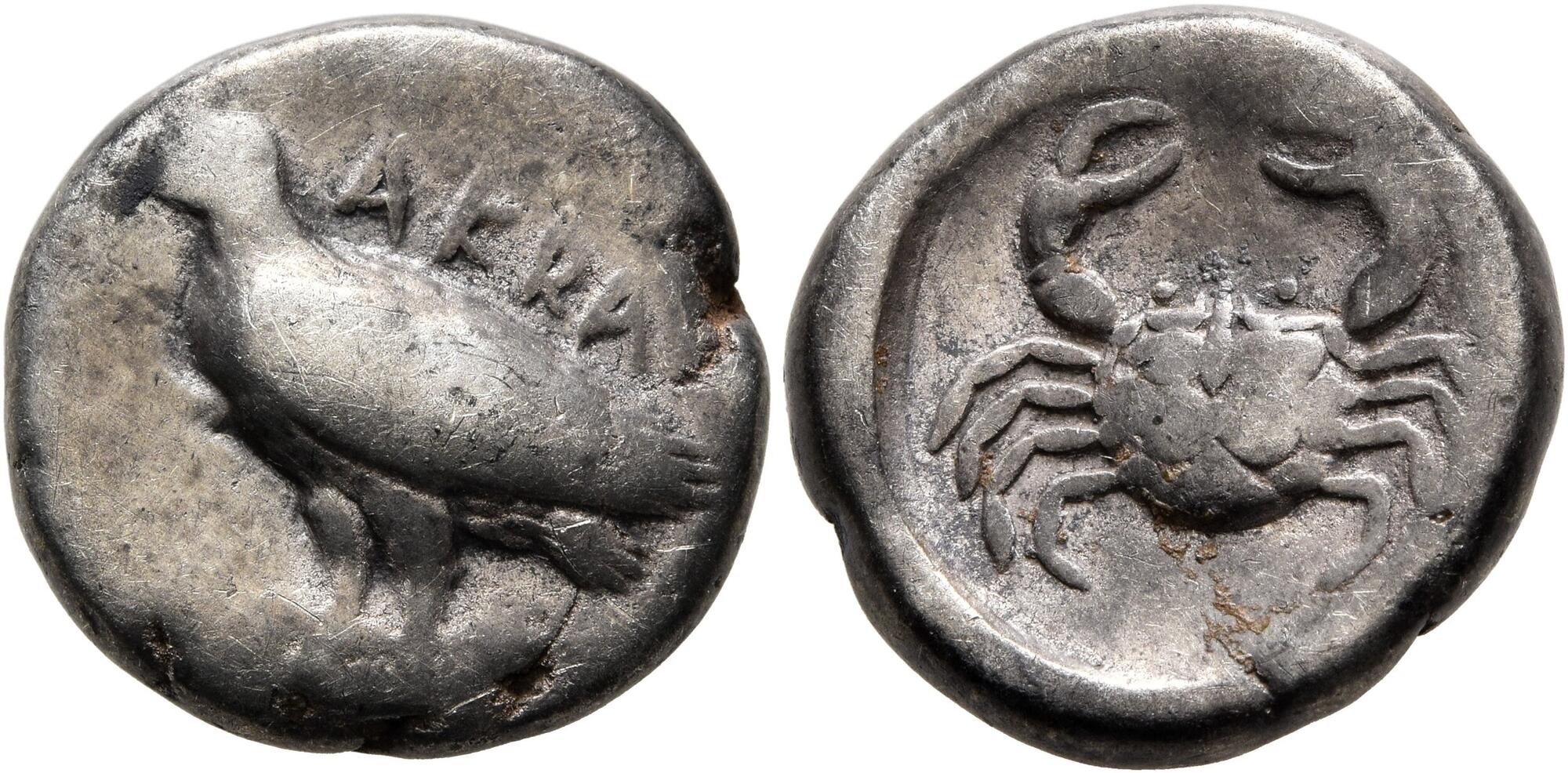1874 - Croton (nomos tripod/incuse tripod) over Agrigentum (eagle/crab) (Künker, EA 31, Oct. 2014, 21)
From SILVER
480 BCE - 430 BCEϘPO
Images
Overstruck variety

Agrigentum crab eagle 495 BCE.jpeg [1]
Location/history
| Sale(s)Sale(s) ᵖ: | Künker, EA 31, 29 Oct. 2014, 21 | |
Overstriking coin
Description
| ObverseInscription or printing placed on the obverse.: | ϘPO (Greek) Tripod. In left field, marsh-bird standing right. | ReverseInscription or printing placed on the reverse.: | Tripod (incuse) |
Mint and issuing power
| MintIdentifies the place of manufacture or issue of a numismatic object.: | Croton | Ancient regionAncient region. | Bruttium | Modern countryModern country: Italy | AuthorityIdentifies the issuing power. The authority can be "pretended" when the name or the portrait of X is on the coin but he/she was not the issuing power. It can also be "uncertain" when there is no mention of X on the coin but he/she was the issuing power according to the historical sources: |
Chronology
| FromIdentifies the initial date in a range assigned in a numismatic context. 480 BCE toIdentifies the final date in a range assigned in a numismatic context.. 430 BCE | Classical 480-323 BC |
Physical description
| MetalThe physical material (usually metal) from which an object is made.: Silver |
DenominationTerm indicating the value of a numismatic object. Examples: tetradrachm, chalkous, denarius.: nomos | ||
| StandardStandard.: Achaian | |||
References
| Coin referenceReference of the Coin: | Coin series referenceReference to coin series study: | HN Italy1HN Italy, n° 2102, 2104 and 2106, HGC 12HGC 1, n° 1449 | |
| Coin series web referenceCoin series web references: | |||
Overstruck type
Description
| ObverseInscription or printing placed on the obverse.: | Eagle | ReverseInscription or printing placed on the reverse.: | Crab (visible on reverse) |
Mint and issuing power
| MintIdentifies the place of manufacture or issue of a numismatic object. ᵖ: | Agrigentum | Ancient regionAncient region. ᵖ | Sicily | Modern countryModern country: Italy | AuthorityIdentifies the authority in whose name (explicitly or implicitly) a numismatic object was issued. ᵖ: |
Chronology
| FromIdentifies the initial date in a range assigned in a numismatic context. 500 BCE toIdentifies the final date in a range assigned in a numismatic context.. 430 BCE | Archaic until 480 BC |
Physical description
| DenominationTerm indicating the value of a numismatic object. Examples: tetradrachm, chalkous, denarius. ᵖ: | didrachm |
References
| Coin type referenceReference to coin series study ᵖ: | Westermark 20183Westermark 2018 | ||
| Coin series web reference overstruckCoin series web references overstruck: | |||
Additional data
| Frequency of overstrikesFrequency of overstrikes: | rare and concentrated | Level of confidenceLevel of confidence of the identification: | sure |
| RemarksRemarks: | |||
References
- ^ Rutter N. Keith et alii (eds.) (2001), Historia Numorum Italy, London, xvi, 223 p., 43 pl.
- ^ Hoover, Oliver D. (2018), The Handbook of Greek Coinage Series, Volume 1. Handbook of Coins of Italy and Magna Graecia, Sixth to First Centuries BC., Lancaster-London, 2018, lxi, 527 pages, 23 cm
- ^ Westermark, Ulla (2018), The coinage of Akragas c. 510-406 BC, 2 vol., Uppsala.
